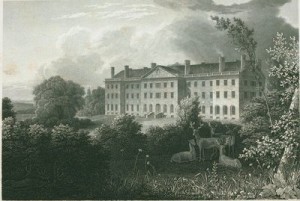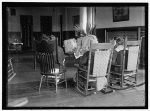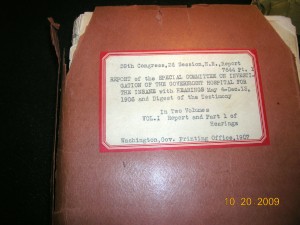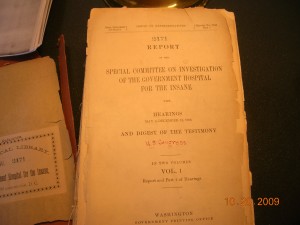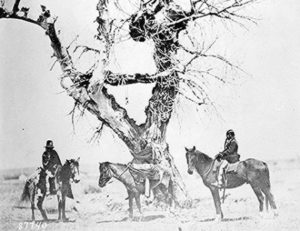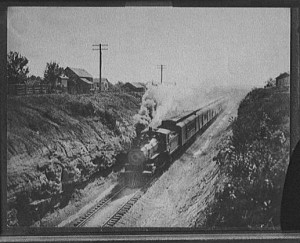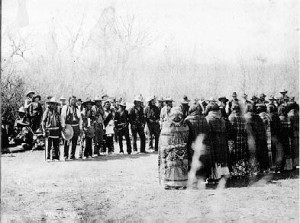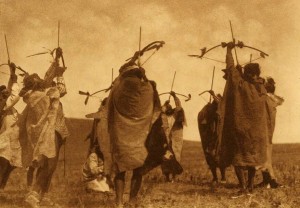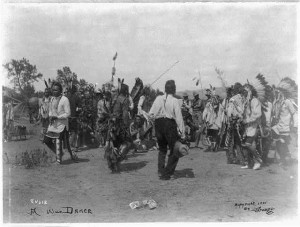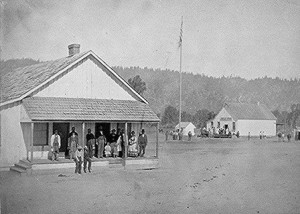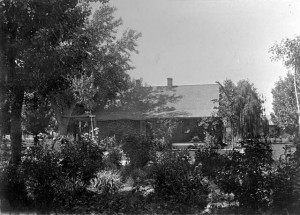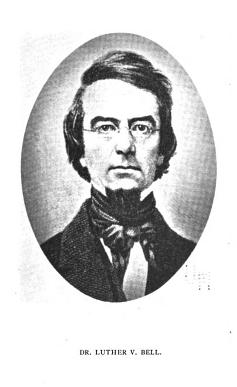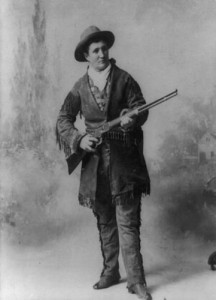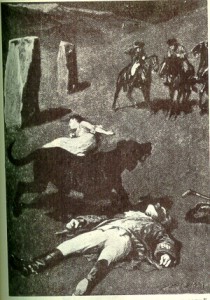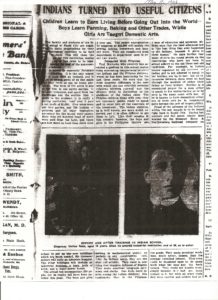The public has always enjoyed a good scandal, and madhouses of the 19th and 20th centuries sometimes provided horrific fodder for newspapers eager to sensationalize problems. Nellie Bly’s stay at Blackwell’s Island Lunatic Asylum was well publicized, but abuses existed elsewhere as well. Continue reading
Category Archives: Canton Asylum for Insane Indians
Bad Management
Investigations into insane asylums, hospitals, prisons, and other public institutions were nothing unusual. Any place that houses unhappy inmates will generate plenty of complaints–some warranted and some not.
Canton Asylum had received a routine inspection in early 1903 and apparently passed with little comment on anyone’s part. It was undoubtedly still so new and small that there wouldn’t have been much to find wrong.
However, an established institution in the nation’s capitol couldn’t avoid scrutiny. In 1906, St. Elizabeths Hospital was targeted by the newly established Medico-Legal Society, who said that St. Elizabeths abused patients. Congress investigated the allegations and gathered over 2,000 pages of testimony–which was often lively, pointed, and contradictory. Some of the patients and their families spoke up on behalf of the care they received at St. Elizabeths, and the motivations of the Medico-Legal Society were questioned in the city’s newspapers.
_________________________________________________________
Death at Canton Asylum
Robert Brings Plenty, a Sioux Indian from South Dakota’s Pine Ridge reservation, was one of Canton Asylum’s first patients. He lasted less than one year, dying of (probably) an epileptic episode on May 20, 1903. Continue reading
Canton Asylum’s First Patients
On January 10, 1903, the superintendent at St. Elizabeths hospital in Washington, D.C. received permission to release its Indian patients to the Canton Asylum for Insane Indians in South Dakota. The first patients were:
Chu-rah-rah-he-kah; Pawnee from the Ponca Agency; suffering from chronic mania
Joseph D. Marshall; Sioux from the Rose Bud Agency; suffering from chronic epileptic dementia
Miguel Maxcy; Mesa Grande froom the Carlisle Indian School; suffering from chronic meloncholia
Robert Brings Plenty; Sioux from the Pine Ridge Agency; suffering from chronic epileptic dementia
John Woodruff; Sioux-Mulatto from the Pine Ridge Agency; suffering from chronic meloncholia
Arch Wolf; Cherokee transferred from the penitentiary at Brooklyn New York; suffering from acute melancholia
These patients arrived at the Canton Asylum under escort of Dr. J.E. Toner, who received $157.71 reimbursement for expenses.
_________________________________________________________
Dancing to their Own Tune
Dancing and music tell stories in many cultures. Native American dances can act as forms of prayer, purification, initiation, ceremony, and healing. The Sun Dance, for instance, had varied forms depending upon the tribe performing it. It was held in late spring or summer (annually) and could last up to four days. The dancers fasted during its performance, and hoped to see a vision.
The Ute Bear Dance was another spring dance, performed when the first thunder was heard. The origins go back several hundred years and show respect for the spirit of the bear. Men and women (who wear shawls) form separate lines and dance in a back and forth pattern. After the four-day dance, men could leave the plumes they were wearing on a cedar tree, and symbolically leave their troubles behind them.
Many Native American dances are still performed today.
__
____
Movers and Shakers: Part Two
The Commissioner of Indian Affairs was a powerful man, but another man was almost as powerful in the daily lives of Native Americans. This was the Indian agent, who for most intents and purposes, made the daily decisions that really affected reservation life.
Indian agents were originally appointed to live among the various tribes, watch their movements, and promote good will via trade, during the Revolutionary War. They reported to superintendents, who reported to Washington. By the mid-nineteenth century, agents reported directly to the commissioner of Indian Affairs and virtually ran the reservations. Most agents were white civilians. They could be honorable men, with the interests of their Indian charges at heart, or they could be petty tyrants. The Indians under their control didn’t have a say in the matter.
_________________________________________________________
Are You Smarter Than An Indian?
In 1905 Alfred Binet (1857-1911) commonly known as the “father” of IQ testing, developed techniques to assess intelligence in primary grade children who were not successful in normal classrooms.
Binet chose a series of 30 short tasks with simple instructions, that related to everyday problems of life. Examples of these tasks are:
- name parts of the body
- compare lengths and weights
- count coins
- assess which of several faces is “prettier”
- name objects in a picture
- define words
Binet then compared the tested child’s results against a norm of “average” children and assigned a mental age to the subject.
He recognized that a test could be intimidating. Binet recommended that: “The examination should take place in a quiet room… […]It is important that when a child sees the experimenter for the first time, he should be reassured by the presence of someone he knows, a relative, an attendant, or a school superintendent. […]If he refuses to reply to a test, pass to the next one, or perhaps offer him a piece of candy; if his silence continues, send him away until another time.”
Imagine the circumstances under which most mental tests would have been administered to Native Americans–who didn’t understand English, or had a different cultural notion of “pretty,” or perhaps had never counted coins. Confused, perhaps intimidated or frightened, many would have been found “defective” by their examiners.
_________________________________________________________
Early Alienists
One early alienist was Luther V. Bell (1806-1862) . He was only 30 years old, and Superintendent at McLean Asylum, when the Association of Medical Superintendents of American Institutions for the Insane first met. Bell observed many cases of insanity at McLean, and wrote about a new form of mania which had formerly been associated with typhoid fever.
Patients were unable to sleep, paranoid in the extreme–often believing their food was poisoned–and frantically violent. Most of the sufferers were strapped into beds so they wouldn’t attack anyone. Bell observed that the patient’s recovery was often as quick as the onset of the condition had been. Most people were well within 3-4 weeks.
Though this condition may seem like a pure example of pseudo-psychiatry as practiced in the early days of alienists, Bell’s Disease has never been dismissed as an erroneous observation. In1981 the term excited delirium was introduced in the Annals of Emergency Medicine to describe this state.
In my next post I’ll describe some of the ways that alienists devised to keep patients quiet when they were in a excited state.
The Last New Century
In 1902, the year Canton Asylum opened, the U.S. was transitioning from raw frontier to settled country. Teddy Roosevelt became the first president to ride in an automobile; J.C. Penny’s opened; and air-conditioning brought relief to sweating workers.
Calamity Jane was still alive, and readers enjoyed a new Sherlock Holmes mystery, The Hound of the Baskervilles, as it was serialized in England’s The Strand magazine.
However, women still couldn’t vote; the Wright brothers had yet to make their first sustained flight; and conveniences like tea bags, zippers, and windshield wipers were years away.
Though the Statue of Liberty had been dedicated in 1886 and poet Emma Lazarus had begged the world to send America its “huddled masses yearning to breathe free,” America was in reality a land controlled by white people rooted in an Anglo-Saxon culture. That cultural background decided what constituted “normal” behavior. The beliefs and behaviors of other peoples or cultures were “inferior” and needed to be upgraded to the white standard. Indians, many who were in power agreed, were inferior.
Read Lazarus’ entire poem
The Sioux Valley News
Newspapers are great resources for a writer; they provide a glimpse into the past that can be hard to duplicate elsewhere. However, I’ve learned to take their news with a grain of salt.
In the newspaper account referenced on my web page, the Sioux Valley News gave a vivid description of a “bad Indian’s” escape from the Canton Asylum. Any staff not occupied turned out for the chase, and Oscar Gifford, the asylum’s superintendent, was the chief pursuer.
Here is a quote from the newspaper: “Up and down the hill he [Gifford] walked and ran, and a cyclometer which was attached to him, registered one hundred miles of travel, during the ten hours he was out scouring the hills.”
Gifford would appear to be an athlete of the highest caliber from this account, which I cannot quite believe. What I do believe, of course, is that the chase took place, covered a good deal of territory, and ended in the capture of the runaway.
The paper’s delight in this satisfactory conclusion is evident, as is its enthusiastic support for its favorite son, Oscar Gifford. While I gleaned a great deal of useful information from the Sioux Valley News, I also read through it with the understanding that the paper’s slant would always be favorable to Canton and its residents.
